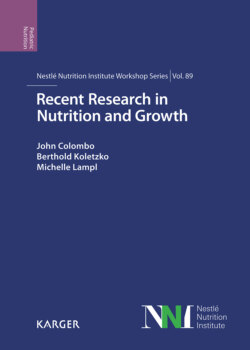Читать книгу Recent Research in Nutrition and Growth - Группа авторов - Страница 15
На сайте Литреса книга снята с продажи.
Size versus Growth
ОглавлениеIt is important to appreciate that the growth chart graphics do not represent actual measurements of children at all ages. Instead, they are group summaries created from measurements taken at monthly to annual intervals during infancy, childhood, and adolescence on either different children across ages or, more rarely, the same children serially. The data are then analyzed to provide descriptive statistics by age at measurement, and mathematical interpolations infer sizes between these ages. The World Health Organization infant growth standards, for example, include data collected longitudinally from only 882 infants at 1, 2, 4, and 6 weeks of age, followed by monthly assessments to 1 year and bimonthly to 2 years. The size-for-age percentiles were calculated and a connect-the-dot procedure joined common percentiles across ages [2]. The interpolated curves of relative size for age emerge as graphical charts, particularly useful for identifying relatively small and relatively large individual children, who are frequently those at greatest health risk.
As interpolated mathematical functions of group data, growth charts are not designed to illustrate how individual children actually grow or change in size across time [3]. Contrary to popular assumptions, individual children do not grow by a biology that matches the visual growth curve images – a slow and steady, continuous day-to-day accrual of small increments. Instead, growing is a process that unfolds within an individual as they age, with a pace and tempo that differs among children [4]. This is evident in the substantial variability in size-for-age curves in children, with some 10–20 cm distinguishing the relatively short and relatively tall individuals between birth and 5 years, respectively [1]. These differences do not merely reflect sizes already in place at birth that unfold across time according to a similar growth rate, as implied by the growth charts and assumed by clinical practice [5]. More than 60% of normally growing infants experience both catchup and -down growth across their first year of life [6], manifest as graphical divergences across 2 or more growth percentile lines with age. Such graphical deviations from the curves reflect normal variability in individual growth rates [4].
The size of an individual at any age only summarizes how much growth has occurred previously, but it provides no information on the process by which that size was achieved. In order to identify best practices for assessing nutritional effects on growth, it is necessary to better understand how individual children actually grow. Greater clarity regarding these biological specifics requires 3 initial steps. The first step is to recognize that the object of study needs to be the individual: individuals are the nutrient consumers. Their individual physiologies summarize these inputs at the level of the whole body as cellular-level processes culminate in tissue deposition and expansion. Statistical summaries from groups of children cannot provide information on these individual-level processes. Second, greater precision in understanding individual growth as a time-ordered process is needed. Individuals do not follow the interpolated growth rates implied by the growth curve. In reality, children do not grow at the same pace each and every day. Third, it is important to appreciate that the body is comprised of a variety of tissues and organs with individual cell types of differing developmental histories and growth trajectories.
Assessing outcomes of nutritional interventions for an individual is not as simple as it has been practiced. The common protocol for assessing nutritional influences on human growth at the whole-body level as weight or length/height outcomes is problematic. These variables indicate gross size, but they are insensitive proxies for the specific tissues accrued and poor markers of outcome due to methodological issues. For example, weight is more informative about calorie balance and/or hydration status than either tissue expansion or cellular physiology. Height changes are often attributed meaning in accord with growth chart comparisons to a statistical sampling reference point – they are not a reflection of individual-level skeletal biology. Closer inspection of the details underlying individual growth biology is needed to evaluate the efficacy of feeding strategies aimed to promote healthy growth among children. Health is about functional physiology and not merely size.
